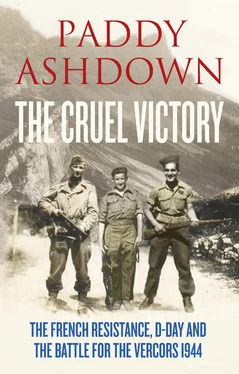De Gaulle was predictably furious at the snub. But it also presented him with a real practical problem. If he knew nothing of Allied plans, how could he ensure that the Resistance would be in a position to assist when the great moment came? His answer was to set up a special planning unit in December 1943 to prepare a ‘rational plan for the participation of Resistance activity in the eventuality of an Allied landing on French soil’, without having the first idea where the landings would be, what form they would take or how they would be exploited. De Gaulle made his position clear in a speech given on 8 October 1943, in liberated Corsica: ‘Victory is approaching. It will be the victory of liberty. How could such a victory not be the victory of France as well?’
One of the key staff in the planning unit de Gaulle had set up was an exceptionally able captain of Czech origin, Ferdinand Otto Miksche. On 20 January 1944, Miksche produced a study listing the options before the British and American planners, drawing conclusions about which in the end they would be most likely to choose. It was astonishingly accurate in predicting that one of the most likely landing points was Normandy – a conclusion which would have deeply worried France’s allies, who were trying desperately to keep the location of Overlord secret. This study also proposed possible military actions which could be undertaken by the Resistance to assist the invasion, wherever it occurred. These were discussed with the British, who ‘showed a great deal of interest and asked for a second … detailed study of the conditions under which French resistance would help in the landing’.
In Miksche’s second study he stressed (somewhat hopefully) that the Resistance ‘although not an ensemble of regular military units [should] be looked upon as a regular Army obeying orders from the Allied High Command’. He also identified several territorial zones of France and how the Resistance might be employed as the Allied breakout from the beachhead developed. Among these were areas where ‘redoubts of Resistance’ would be established ‘in districts geographically unsuitable for large scale military operations’, such as the Alps (including the Vercors). Miksche’s plan continued the drift towards something more ambitious and permanent than Dalloz’s original Plan Montagnards (of which at this stage he had no knowledge). ‘In these redoubts’, he wrote, ‘the Maquis would be organized and be in readiness for sabotage and guerrilla operation behind enemy lines … the creation of permanent redoubts [emphasis added] would inevitably expand, even before D-Day, through the arrival of patriots who refused to accept forced labour for the enemy.’
The idea of ‘Resistance redoubts’ ( réduits in French) was not a new one. On 13 November 1943, a secret meeting in Switzerland between British SOE representatives and a gathering of Resistance and Secret Army leaders (who were also unaware of the existence of Plan Montagnards) concluded with a recommendation that the Vercors (among other possible ‘redoubt’ areas) should be held ‘as a fortress from which raids could be made’ on German lines of communication. Two weeks later, on 29 November 1943, an experienced French agent, in London at the time, wrote a paper picking up on the fortress idea and proposing the establishment of ‘geographic fortresses’ manned by ‘trained, disciplined, adequately armed and properly led forces’ in places like the Vercors. The aim was ‘to place at the disposition of the Allied High Command, forces under their direct control which could offer operational possibilities comparable with parachute troops dropped in advance. These should be kept hidden until after, or exceptionally a little before, D-Day.’ Note the key proposition here. The Maquis would not create an area for paratroopers, but would instead take on the role of paratroopers dropped in advance.
On 31 December 1943, an SOE paper followed up this thinking and proposed that ‘small controlled areas’ should be created for the delivery of weapons and paratroops after D-Day. These would be established where ‘the Maquis [could] occupy ground which can be comparatively easily defended and thus controlled’. This imprecise language left it open for some to believe that the Maquis could defend these controlled areas by themselves. In the fertile soil around this lacuna, muddled thinking, unclear orders and military folie de grandeur would take root, flourish and ultimately cost the lives of many hundreds of the young, the inexperienced and the innocent.
Pierre Dalloz arrived in Algiers on 25 November 1943 having completed a long and hazardous crossing of France under the false identity of René Brunet, an even more dangerous one over the snow-bound passes of the Pyrenees and a short stay in Gibraltar. He was horrified that no record of or interest in Plan Montagnards could be found in any quarter. He immediately sat down and reconstructed the plan from memory, dictating it to the personal secretary of one of de Gaulle’s most senior advisers (see Annex B). It was to be to no avail. When Dalloz finally arrived in London at the end of January 1944, he was to find that those who should have been aware of his plan were as ignorant of its existence in the British capital as their counterparts had been in the North African one.
The truth was that when it came to deciding the fate of the Vercors, the template now being used was not Dalloz’s carefully calibrated Plan Montagnards but something altogether more ambitious. Some among those, British and French, who were directing the Resistance from London were beginning to believe that the young men who had first taken refuge on the Vercors plateau and then been turned into a rough guerrilla fighting force might, in due course and with a little help, be able to take on a face-to-face defensive battle with the gathered might of the German Army.
Between Christmas and New Year – at about the same time that Churchill in his sickbed in Carthage was concluding he had to take the French Resistance more seriously – one of London’s ‘mission leaders’, who had now teamed up with the Maquisards on another of the planned redoubts, the Glières plateau east of Geneva, sent a message to London: ‘We consider that the Glières plateau is now an impregnable fortress.’
It would not be long before this boast, and with it the developing concept of the ‘defendable redoubt’, would be tested.
Emmanuel d’Astier de La Vigérie, aristocrat, adventurer, libertine, Socialist, one-time self-proclaimed Communist, eternal optimist, Resistance leader and senior member of de Gaulle’s government-in-exile in Algiers, was summoned to attend the British Prime Minister in the Villa Taylor in Marrakesh at 10.00 on 15 January 1944. De Gaulle himself had just flown back to Algiers, having been in Marrakesh for a morning parade of troops, over which he and Churchill had jointly presided as a show of unity between the two men. It may even have been that Churchill had deliberately waited for the General’s departure before calling d’Astier to see him.
D’Astier records that when he arrived at the Villa Taylor ‘Duff Cooper was there, as was Macmillan just back from Egypt … Clementine and Mary Churchill were on the terrace together with Diana Cooper, who despite her straw hat and chiffon veil looked like a Rossetti painting. Although it was winter it was as warm as a May day on the Île de France. An ADC came for me and led me through darkened rooms to a modest door which opened to reveal Churchill sitting in a large bed, a cigar clamped between his teeth. The nurse attending him stood up and left; the chamber was as small, sparse and white as a hospital room. Somewhat intimidated I stumbled into my first words in English but was soon at my ease … He was an accomplished verbal jouster – never quibbling over positions which he knew were untenable … always knowing when to feint and when to riposte, jumping from word to word, barking with anger from time to time, but chiefly for effect (though it brought the nurse scurrying back in on one occasion to relieve him of his cigar and put it out).’
Читать дальше












